The Principles of Disclosure: Communication in Financial Reporting
VerifiedAdded on 2022/09/14
|12
|3134
|13
Report
AI Summary
This report provides a comprehensive analysis of the principles of disclosure in financial reporting, focusing on the International Accounting Standards Board (IASB)'s efforts to enhance communication within financial statements. It begins by outlining the IASB's rationale for undertaking the Disclosure Initiative, driven by stakeholder concerns regarding insufficient relevant information, excessive irrelevant information, and ineffective communication. The report then delves into these 'disclosure problems,' identifying their causes and the IASB's proposed solutions. A significant portion is dedicated to examining the amendments to IAS 1 (Presentation of Financial Statements) and IAS 7 (Statement of Cash Flows), detailing their objectives and impact on financial reporting practices. The report also explores the role of materiality in shaping disclosures and presentations, referencing the IFRS Practice Statement 2. Through this analysis, the report aims to provide a clear understanding of the IASB's initiatives and their implications for improving the clarity, relevance, and effectiveness of financial reporting.
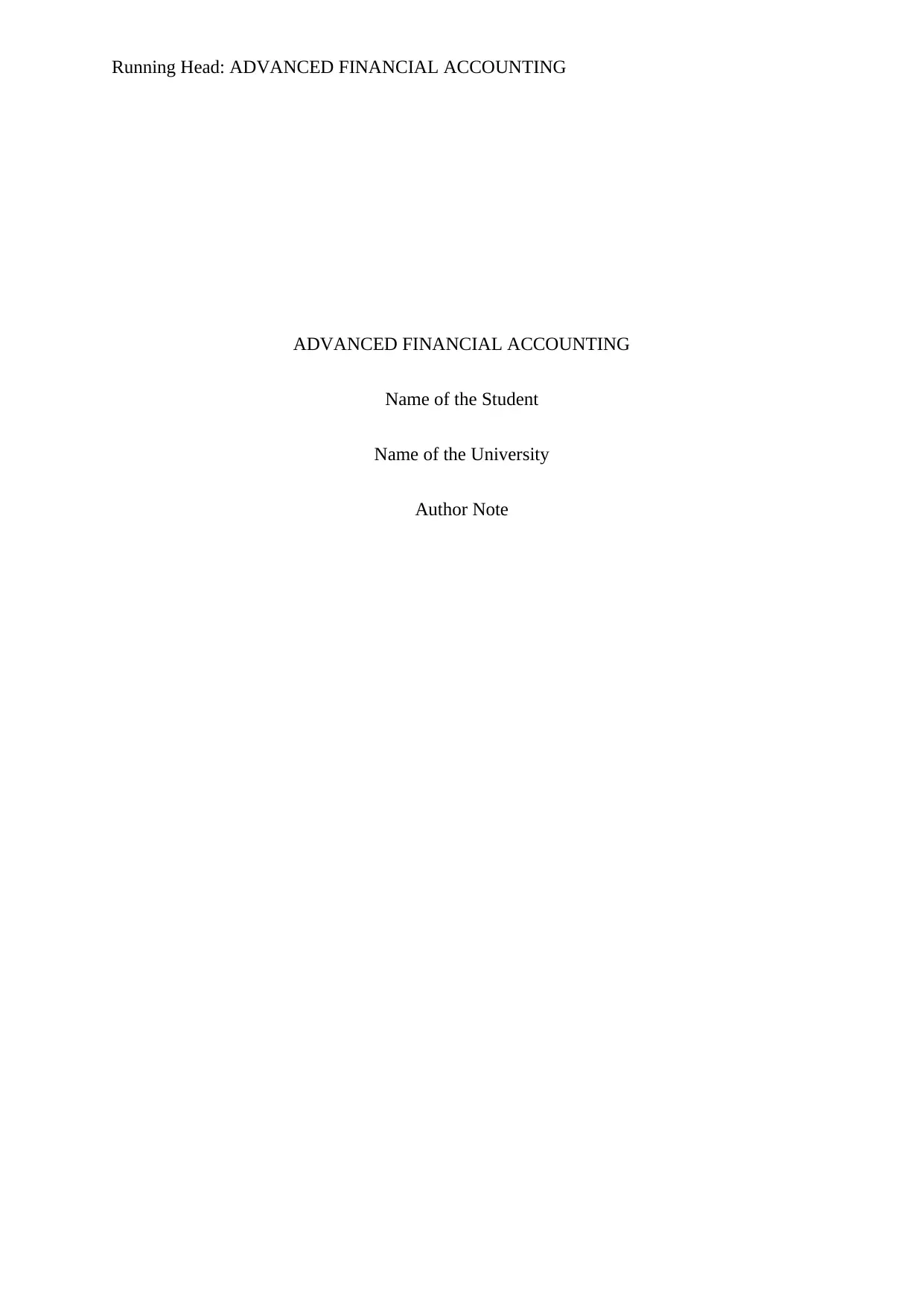
Running Head: ADVANCED FINANCIAL ACCOUNTING
ADVANCED FINANCIAL ACCOUNTING
Name of the Student
Name of the University
Author Note
ADVANCED FINANCIAL ACCOUNTING
Name of the Student
Name of the University
Author Note
Paraphrase This Document
Need a fresh take? Get an instant paraphrase of this document with our AI Paraphraser
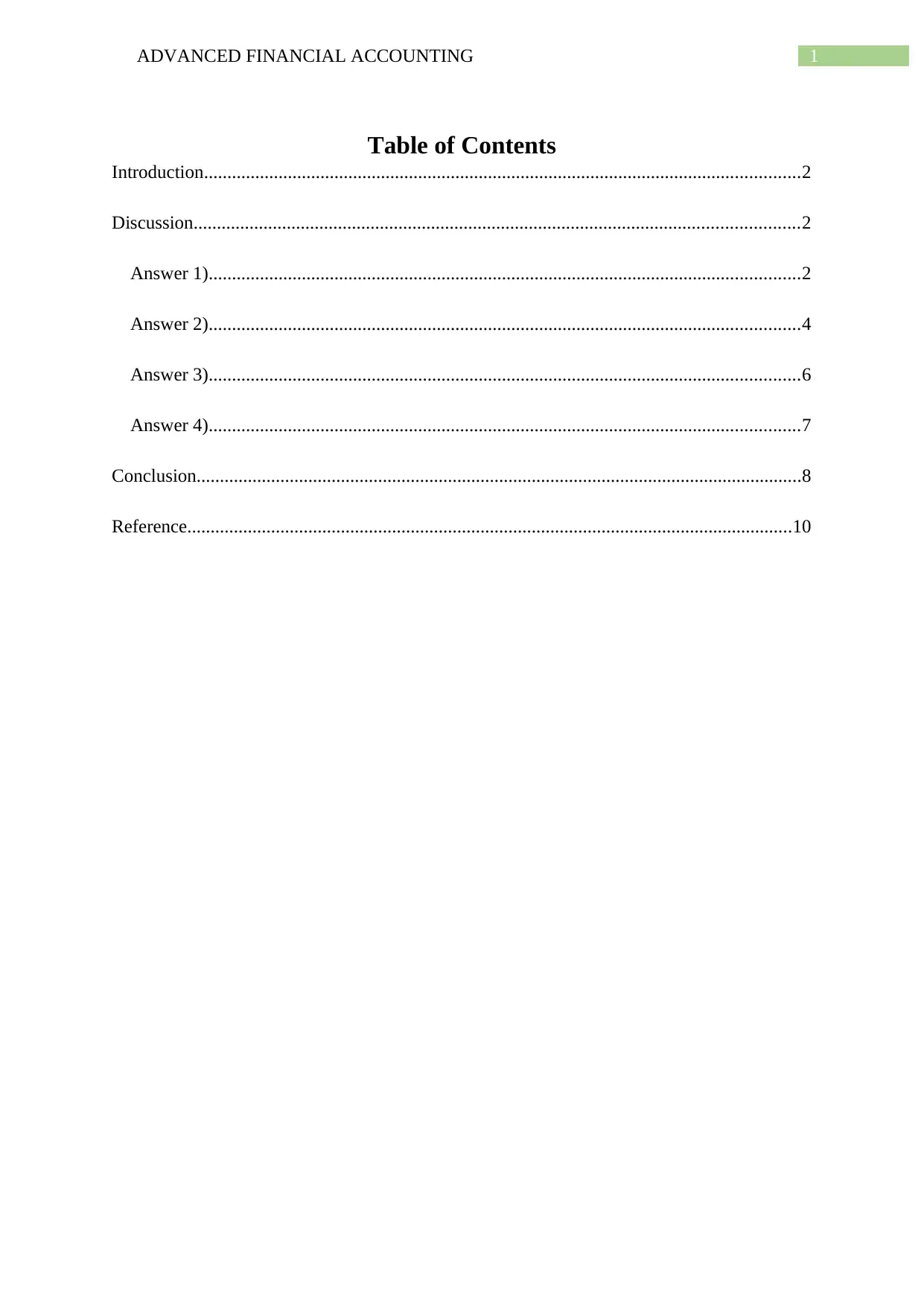
1ADVANCED FINANCIAL ACCOUNTING
Table of Contents
Introduction................................................................................................................................2
Discussion..................................................................................................................................2
Answer 1)...............................................................................................................................2
Answer 2)...............................................................................................................................4
Answer 3)...............................................................................................................................6
Answer 4)...............................................................................................................................7
Conclusion..................................................................................................................................8
Reference..................................................................................................................................10
Table of Contents
Introduction................................................................................................................................2
Discussion..................................................................................................................................2
Answer 1)...............................................................................................................................2
Answer 2)...............................................................................................................................4
Answer 3)...............................................................................................................................6
Answer 4)...............................................................................................................................7
Conclusion..................................................................................................................................8
Reference..................................................................................................................................10
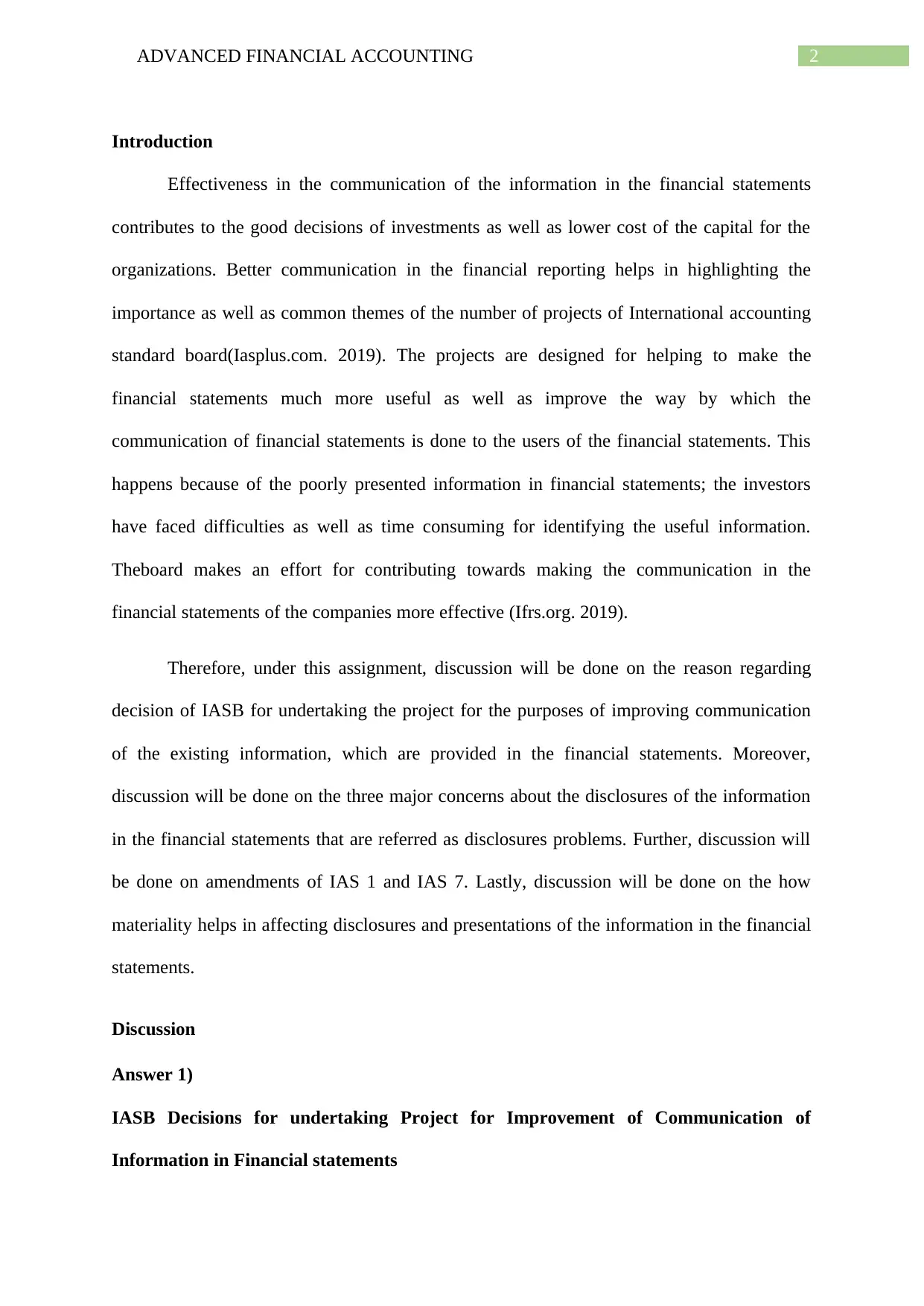
2ADVANCED FINANCIAL ACCOUNTING
Introduction
Effectiveness in the communication of the information in the financial statements
contributes to the good decisions of investments as well as lower cost of the capital for the
organizations. Better communication in the financial reporting helps in highlighting the
importance as well as common themes of the number of projects of International accounting
standard board(Iasplus.com. 2019). The projects are designed for helping to make the
financial statements much more useful as well as improve the way by which the
communication of financial statements is done to the users of the financial statements. This
happens because of the poorly presented information in financial statements; the investors
have faced difficulties as well as time consuming for identifying the useful information.
Theboard makes an effort for contributing towards making the communication in the
financial statements of the companies more effective (Ifrs.org. 2019).
Therefore, under this assignment, discussion will be done on the reason regarding
decision of IASB for undertaking the project for the purposes of improving communication
of the existing information, which are provided in the financial statements. Moreover,
discussion will be done on the three major concerns about the disclosures of the information
in the financial statements that are referred as disclosures problems. Further, discussion will
be done on amendments of IAS 1 and IAS 7. Lastly, discussion will be done on the how
materiality helps in affecting disclosures and presentations of the information in the financial
statements.
Discussion
Answer 1)
IASB Decisions for undertaking Project for Improvement of Communication of
Information in Financial statements
Introduction
Effectiveness in the communication of the information in the financial statements
contributes to the good decisions of investments as well as lower cost of the capital for the
organizations. Better communication in the financial reporting helps in highlighting the
importance as well as common themes of the number of projects of International accounting
standard board(Iasplus.com. 2019). The projects are designed for helping to make the
financial statements much more useful as well as improve the way by which the
communication of financial statements is done to the users of the financial statements. This
happens because of the poorly presented information in financial statements; the investors
have faced difficulties as well as time consuming for identifying the useful information.
Theboard makes an effort for contributing towards making the communication in the
financial statements of the companies more effective (Ifrs.org. 2019).
Therefore, under this assignment, discussion will be done on the reason regarding
decision of IASB for undertaking the project for the purposes of improving communication
of the existing information, which are provided in the financial statements. Moreover,
discussion will be done on the three major concerns about the disclosures of the information
in the financial statements that are referred as disclosures problems. Further, discussion will
be done on amendments of IAS 1 and IAS 7. Lastly, discussion will be done on the how
materiality helps in affecting disclosures and presentations of the information in the financial
statements.
Discussion
Answer 1)
IASB Decisions for undertaking Project for Improvement of Communication of
Information in Financial statements
⊘ This is a preview!⊘
Do you want full access?
Subscribe today to unlock all pages.

Trusted by 1+ million students worldwide
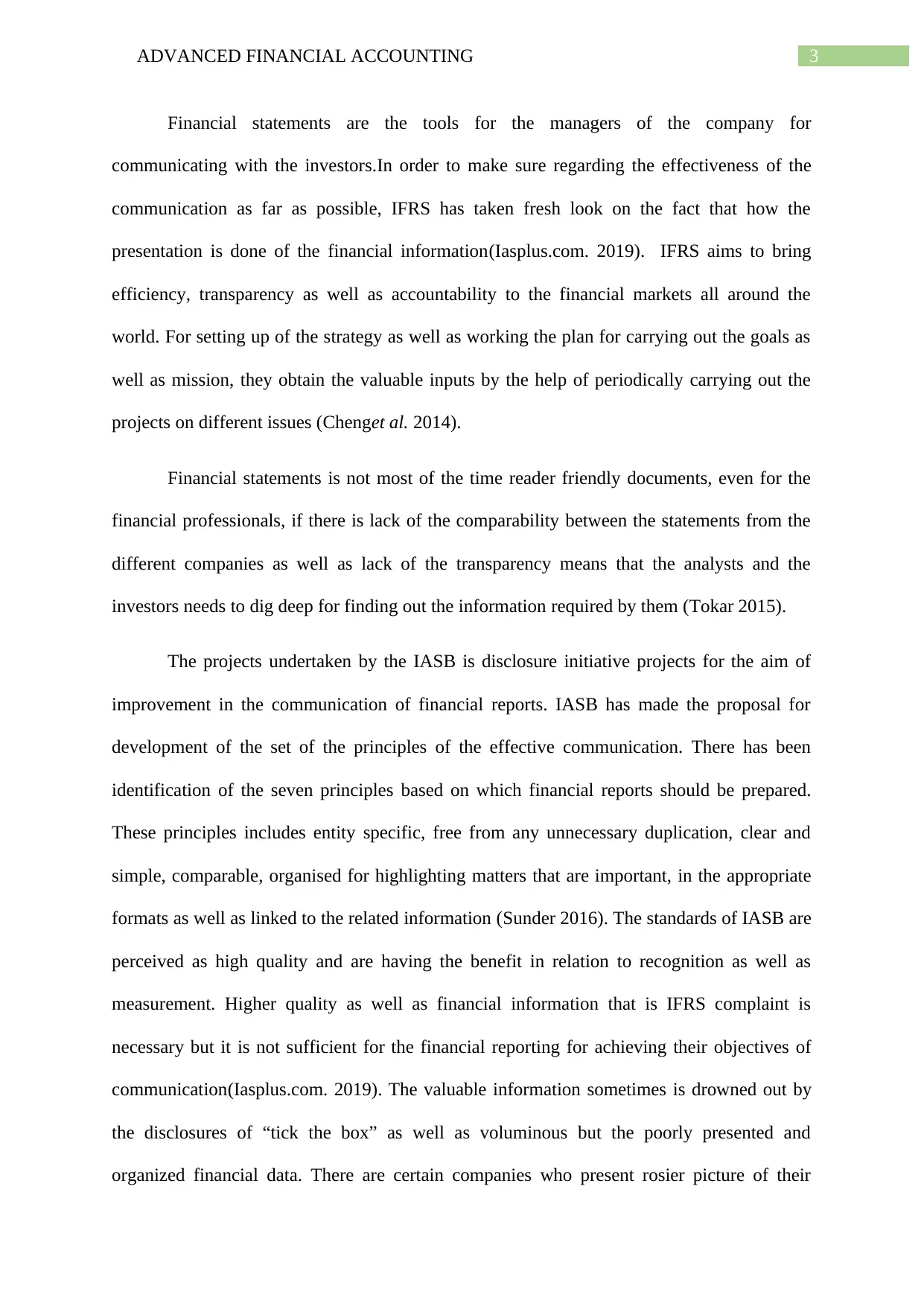
3ADVANCED FINANCIAL ACCOUNTING
Financial statements are the tools for the managers of the company for
communicating with the investors.In order to make sure regarding the effectiveness of the
communication as far as possible, IFRS has taken fresh look on the fact that how the
presentation is done of the financial information(Iasplus.com. 2019). IFRS aims to bring
efficiency, transparency as well as accountability to the financial markets all around the
world. For setting up of the strategy as well as working the plan for carrying out the goals as
well as mission, they obtain the valuable inputs by the help of periodically carrying out the
projects on different issues (Chenget al. 2014).
Financial statements is not most of the time reader friendly documents, even for the
financial professionals, if there is lack of the comparability between the statements from the
different companies as well as lack of the transparency means that the analysts and the
investors needs to dig deep for finding out the information required by them (Tokar 2015).
The projects undertaken by the IASB is disclosure initiative projects for the aim of
improvement in the communication of financial reports. IASB has made the proposal for
development of the set of the principles of the effective communication. There has been
identification of the seven principles based on which financial reports should be prepared.
These principles includes entity specific, free from any unnecessary duplication, clear and
simple, comparable, organised for highlighting matters that are important, in the appropriate
formats as well as linked to the related information (Sunder 2016). The standards of IASB are
perceived as high quality and are having the benefit in relation to recognition as well as
measurement. Higher quality as well as financial information that is IFRS complaint is
necessary but it is not sufficient for the financial reporting for achieving their objectives of
communication(Iasplus.com. 2019). The valuable information sometimes is drowned out by
the disclosures of “tick the box” as well as voluminous but the poorly presented and
organized financial data. There are certain companies who present rosier picture of their
Financial statements are the tools for the managers of the company for
communicating with the investors.In order to make sure regarding the effectiveness of the
communication as far as possible, IFRS has taken fresh look on the fact that how the
presentation is done of the financial information(Iasplus.com. 2019). IFRS aims to bring
efficiency, transparency as well as accountability to the financial markets all around the
world. For setting up of the strategy as well as working the plan for carrying out the goals as
well as mission, they obtain the valuable inputs by the help of periodically carrying out the
projects on different issues (Chenget al. 2014).
Financial statements is not most of the time reader friendly documents, even for the
financial professionals, if there is lack of the comparability between the statements from the
different companies as well as lack of the transparency means that the analysts and the
investors needs to dig deep for finding out the information required by them (Tokar 2015).
The projects undertaken by the IASB is disclosure initiative projects for the aim of
improvement in the communication of financial reports. IASB has made the proposal for
development of the set of the principles of the effective communication. There has been
identification of the seven principles based on which financial reports should be prepared.
These principles includes entity specific, free from any unnecessary duplication, clear and
simple, comparable, organised for highlighting matters that are important, in the appropriate
formats as well as linked to the related information (Sunder 2016). The standards of IASB are
perceived as high quality and are having the benefit in relation to recognition as well as
measurement. Higher quality as well as financial information that is IFRS complaint is
necessary but it is not sufficient for the financial reporting for achieving their objectives of
communication(Iasplus.com. 2019). The valuable information sometimes is drowned out by
the disclosures of “tick the box” as well as voluminous but the poorly presented and
organized financial data. There are certain companies who present rosier picture of their
Paraphrase This Document
Need a fresh take? Get an instant paraphrase of this document with our AI Paraphraser
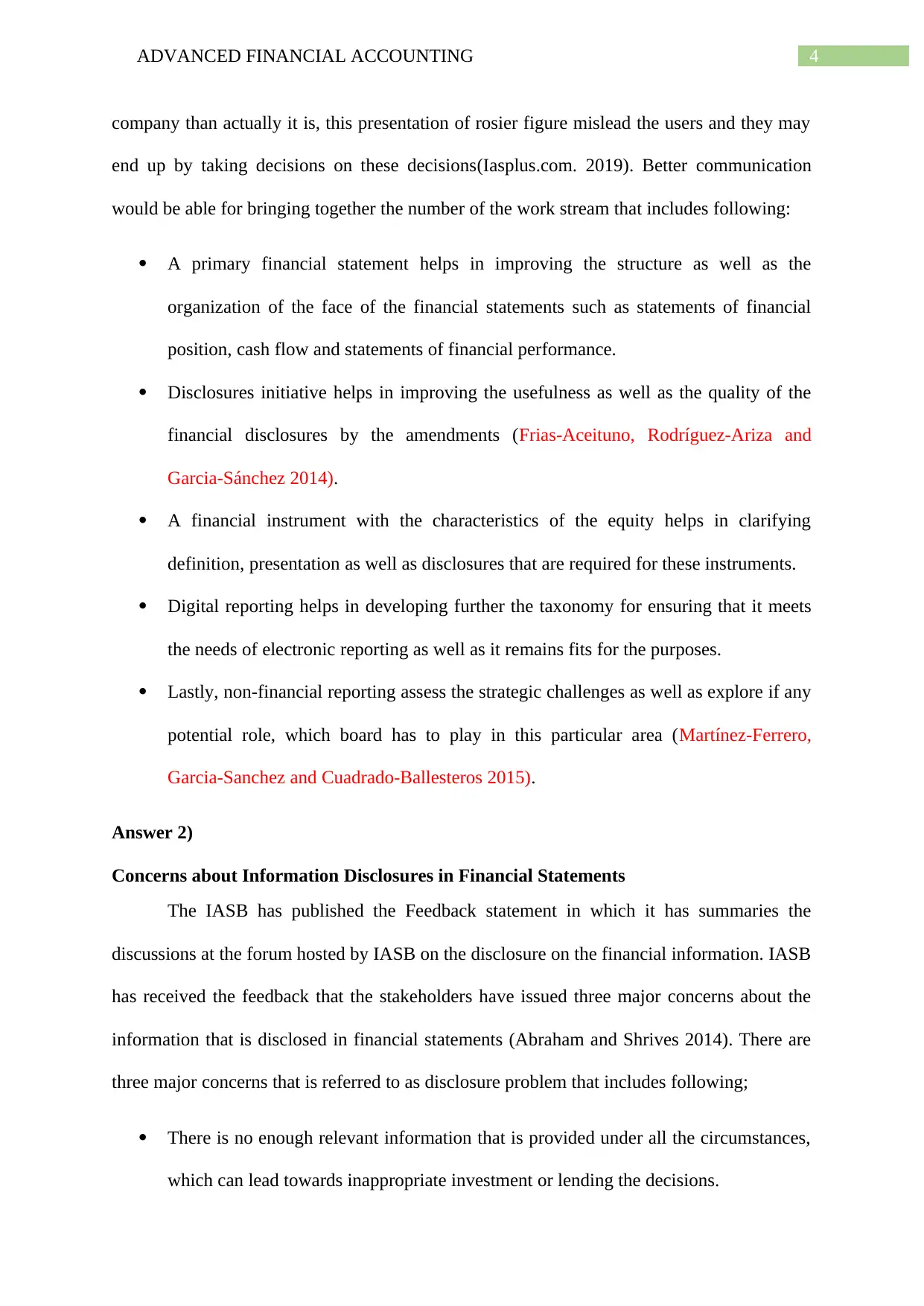
4ADVANCED FINANCIAL ACCOUNTING
company than actually it is, this presentation of rosier figure mislead the users and they may
end up by taking decisions on these decisions(Iasplus.com. 2019). Better communication
would be able for bringing together the number of the work stream that includes following:
A primary financial statement helps in improving the structure as well as the
organization of the face of the financial statements such as statements of financial
position, cash flow and statements of financial performance.
Disclosures initiative helps in improving the usefulness as well as the quality of the
financial disclosures by the amendments (Frias‐Aceituno, Rodríguez‐Ariza and
Garcia‐Sánchez 2014).
A financial instrument with the characteristics of the equity helps in clarifying
definition, presentation as well as disclosures that are required for these instruments.
Digital reporting helps in developing further the taxonomy for ensuring that it meets
the needs of electronic reporting as well as it remains fits for the purposes.
Lastly, non-financial reporting assess the strategic challenges as well as explore if any
potential role, which board has to play in this particular area (Martínez‐Ferrero,
Garcia‐Sanchez and Cuadrado‐Ballesteros 2015).
Answer 2)
Concerns about Information Disclosures in Financial Statements
The IASB has published the Feedback statement in which it has summaries the
discussions at the forum hosted by IASB on the disclosure on the financial information. IASB
has received the feedback that the stakeholders have issued three major concerns about the
information that is disclosed in financial statements (Abraham and Shrives 2014). There are
three major concerns that is referred to as disclosure problem that includes following;
There is no enough relevant information that is provided under all the circumstances,
which can lead towards inappropriate investment or lending the decisions.
company than actually it is, this presentation of rosier figure mislead the users and they may
end up by taking decisions on these decisions(Iasplus.com. 2019). Better communication
would be able for bringing together the number of the work stream that includes following:
A primary financial statement helps in improving the structure as well as the
organization of the face of the financial statements such as statements of financial
position, cash flow and statements of financial performance.
Disclosures initiative helps in improving the usefulness as well as the quality of the
financial disclosures by the amendments (Frias‐Aceituno, Rodríguez‐Ariza and
Garcia‐Sánchez 2014).
A financial instrument with the characteristics of the equity helps in clarifying
definition, presentation as well as disclosures that are required for these instruments.
Digital reporting helps in developing further the taxonomy for ensuring that it meets
the needs of electronic reporting as well as it remains fits for the purposes.
Lastly, non-financial reporting assess the strategic challenges as well as explore if any
potential role, which board has to play in this particular area (Martínez‐Ferrero,
Garcia‐Sanchez and Cuadrado‐Ballesteros 2015).
Answer 2)
Concerns about Information Disclosures in Financial Statements
The IASB has published the Feedback statement in which it has summaries the
discussions at the forum hosted by IASB on the disclosure on the financial information. IASB
has received the feedback that the stakeholders have issued three major concerns about the
information that is disclosed in financial statements (Abraham and Shrives 2014). There are
three major concerns that is referred to as disclosure problem that includes following;
There is no enough relevant information that is provided under all the circumstances,
which can lead towards inappropriate investment or lending the decisions.
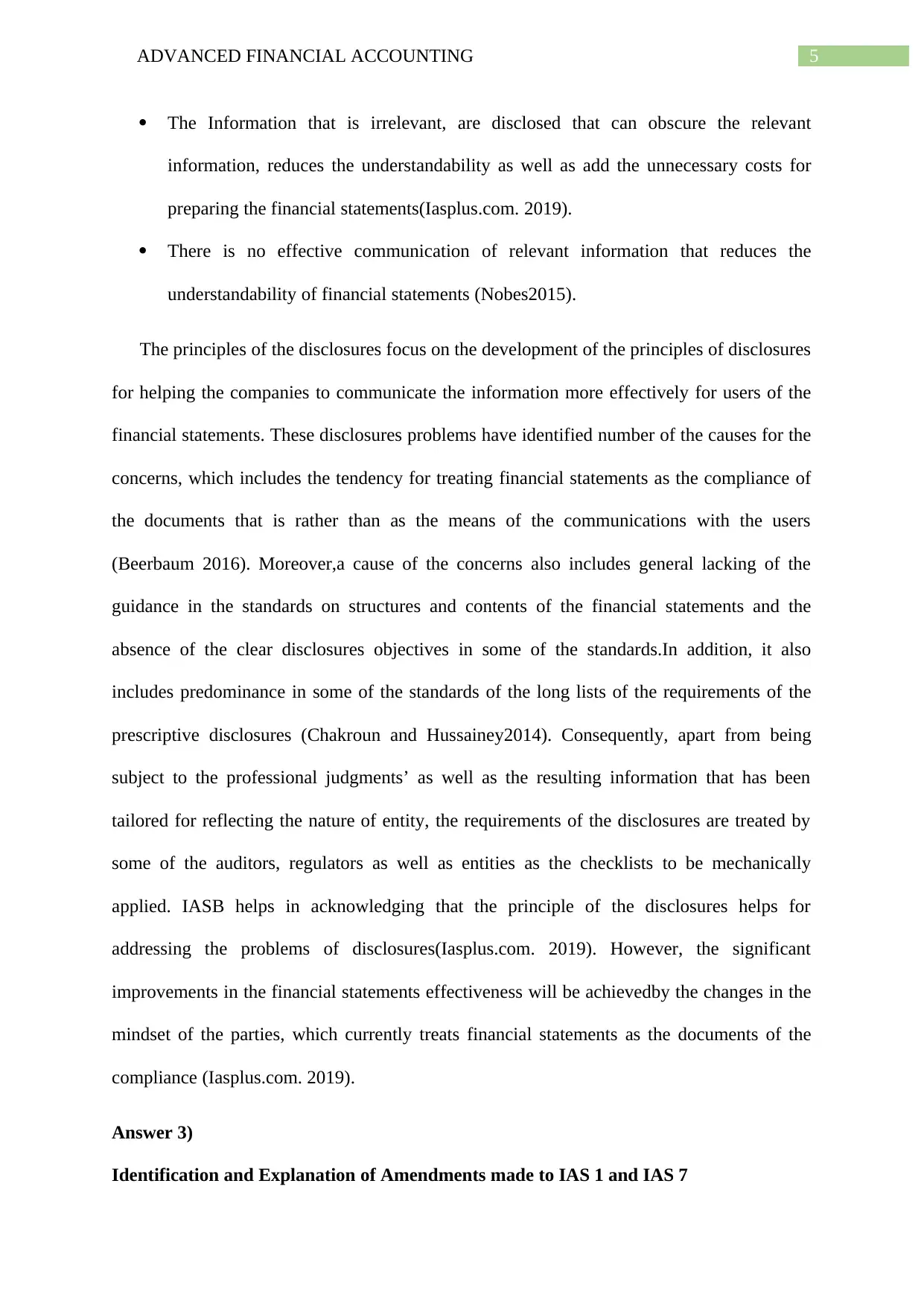
5ADVANCED FINANCIAL ACCOUNTING
The Information that is irrelevant, are disclosed that can obscure the relevant
information, reduces the understandability as well as add the unnecessary costs for
preparing the financial statements(Iasplus.com. 2019).
There is no effective communication of relevant information that reduces the
understandability of financial statements (Nobes2015).
The principles of the disclosures focus on the development of the principles of disclosures
for helping the companies to communicate the information more effectively for users of the
financial statements. These disclosures problems have identified number of the causes for the
concerns, which includes the tendency for treating financial statements as the compliance of
the documents that is rather than as the means of the communications with the users
(Beerbaum 2016). Moreover,a cause of the concerns also includes general lacking of the
guidance in the standards on structures and contents of the financial statements and the
absence of the clear disclosures objectives in some of the standards.In addition, it also
includes predominance in some of the standards of the long lists of the requirements of the
prescriptive disclosures (Chakroun and Hussainey2014). Consequently, apart from being
subject to the professional judgments’ as well as the resulting information that has been
tailored for reflecting the nature of entity, the requirements of the disclosures are treated by
some of the auditors, regulators as well as entities as the checklists to be mechanically
applied. IASB helps in acknowledging that the principle of the disclosures helps for
addressing the problems of disclosures(Iasplus.com. 2019). However, the significant
improvements in the financial statements effectiveness will be achievedby the changes in the
mindset of the parties, which currently treats financial statements as the documents of the
compliance (Iasplus.com. 2019).
Answer 3)
Identification and Explanation of Amendments made to IAS 1 and IAS 7
The Information that is irrelevant, are disclosed that can obscure the relevant
information, reduces the understandability as well as add the unnecessary costs for
preparing the financial statements(Iasplus.com. 2019).
There is no effective communication of relevant information that reduces the
understandability of financial statements (Nobes2015).
The principles of the disclosures focus on the development of the principles of disclosures
for helping the companies to communicate the information more effectively for users of the
financial statements. These disclosures problems have identified number of the causes for the
concerns, which includes the tendency for treating financial statements as the compliance of
the documents that is rather than as the means of the communications with the users
(Beerbaum 2016). Moreover,a cause of the concerns also includes general lacking of the
guidance in the standards on structures and contents of the financial statements and the
absence of the clear disclosures objectives in some of the standards.In addition, it also
includes predominance in some of the standards of the long lists of the requirements of the
prescriptive disclosures (Chakroun and Hussainey2014). Consequently, apart from being
subject to the professional judgments’ as well as the resulting information that has been
tailored for reflecting the nature of entity, the requirements of the disclosures are treated by
some of the auditors, regulators as well as entities as the checklists to be mechanically
applied. IASB helps in acknowledging that the principle of the disclosures helps for
addressing the problems of disclosures(Iasplus.com. 2019). However, the significant
improvements in the financial statements effectiveness will be achievedby the changes in the
mindset of the parties, which currently treats financial statements as the documents of the
compliance (Iasplus.com. 2019).
Answer 3)
Identification and Explanation of Amendments made to IAS 1 and IAS 7
⊘ This is a preview!⊘
Do you want full access?
Subscribe today to unlock all pages.

Trusted by 1+ million students worldwide
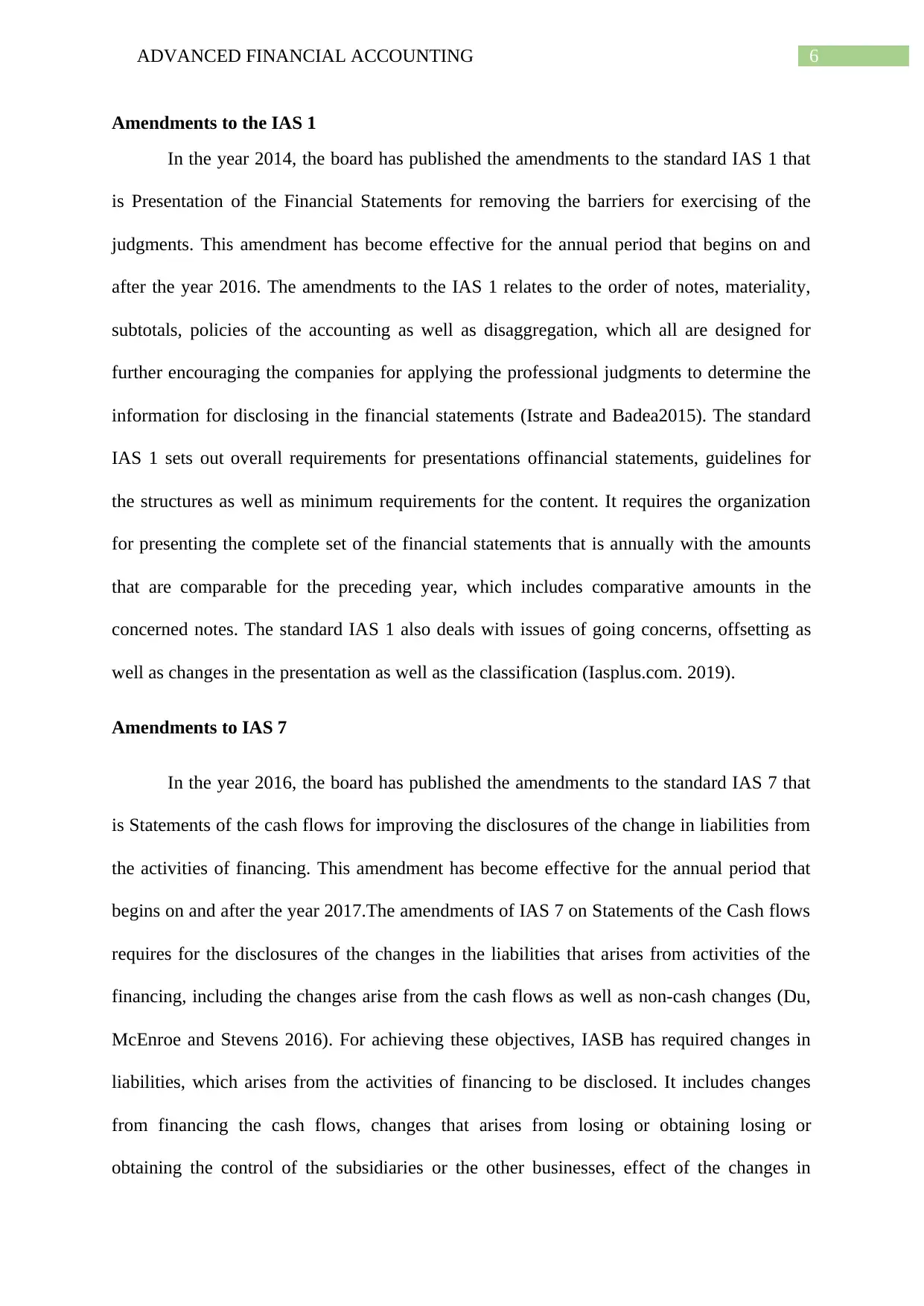
6ADVANCED FINANCIAL ACCOUNTING
Amendments to the IAS 1
In the year 2014, the board has published the amendments to the standard IAS 1 that
is Presentation of the Financial Statements for removing the barriers for exercising of the
judgments. This amendment has become effective for the annual period that begins on and
after the year 2016. The amendments to the IAS 1 relates to the order of notes, materiality,
subtotals, policies of the accounting as well as disaggregation, which all are designed for
further encouraging the companies for applying the professional judgments to determine the
information for disclosing in the financial statements (Istrate and Badea2015). The standard
IAS 1 sets out overall requirements for presentations offinancial statements, guidelines for
the structures as well as minimum requirements for the content. It requires the organization
for presenting the complete set of the financial statements that is annually with the amounts
that are comparable for the preceding year, which includes comparative amounts in the
concerned notes. The standard IAS 1 also deals with issues of going concerns, offsetting as
well as changes in the presentation as well as the classification (Iasplus.com. 2019).
Amendments to IAS 7
In the year 2016, the board has published the amendments to the standard IAS 7 that
is Statements of the cash flows for improving the disclosures of the change in liabilities from
the activities of financing. This amendment has become effective for the annual period that
begins on and after the year 2017.The amendments of IAS 7 on Statements of the Cash flows
requires for the disclosures of the changes in the liabilities that arises from activities of the
financing, including the changes arise from the cash flows as well as non-cash changes (Du,
McEnroe and Stevens 2016). For achieving these objectives, IASB has required changes in
liabilities, which arises from the activities of financing to be disclosed. It includes changes
from financing the cash flows, changes that arises from losing or obtaining losing or
obtaining the control of the subsidiaries or the other businesses, effect of the changes in
Amendments to the IAS 1
In the year 2014, the board has published the amendments to the standard IAS 1 that
is Presentation of the Financial Statements for removing the barriers for exercising of the
judgments. This amendment has become effective for the annual period that begins on and
after the year 2016. The amendments to the IAS 1 relates to the order of notes, materiality,
subtotals, policies of the accounting as well as disaggregation, which all are designed for
further encouraging the companies for applying the professional judgments to determine the
information for disclosing in the financial statements (Istrate and Badea2015). The standard
IAS 1 sets out overall requirements for presentations offinancial statements, guidelines for
the structures as well as minimum requirements for the content. It requires the organization
for presenting the complete set of the financial statements that is annually with the amounts
that are comparable for the preceding year, which includes comparative amounts in the
concerned notes. The standard IAS 1 also deals with issues of going concerns, offsetting as
well as changes in the presentation as well as the classification (Iasplus.com. 2019).
Amendments to IAS 7
In the year 2016, the board has published the amendments to the standard IAS 7 that
is Statements of the cash flows for improving the disclosures of the change in liabilities from
the activities of financing. This amendment has become effective for the annual period that
begins on and after the year 2017.The amendments of IAS 7 on Statements of the Cash flows
requires for the disclosures of the changes in the liabilities that arises from activities of the
financing, including the changes arise from the cash flows as well as non-cash changes (Du,
McEnroe and Stevens 2016). For achieving these objectives, IASB has required changes in
liabilities, which arises from the activities of financing to be disclosed. It includes changes
from financing the cash flows, changes that arises from losing or obtaining losing or
obtaining the control of the subsidiaries or the other businesses, effect of the changes in
Paraphrase This Document
Need a fresh take? Get an instant paraphrase of this document with our AI Paraphraser
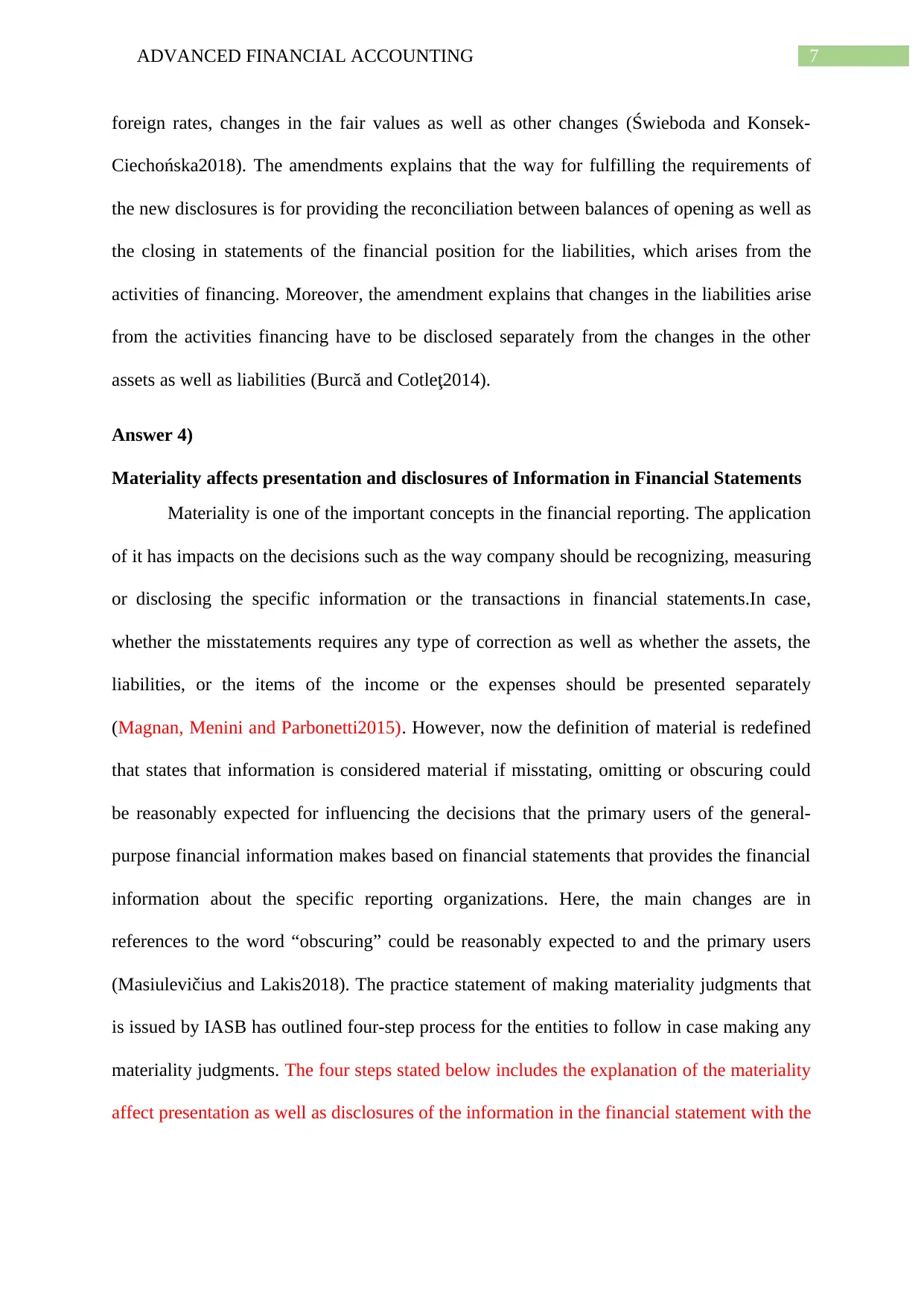
7ADVANCED FINANCIAL ACCOUNTING
foreign rates, changes in the fair values as well as other changes (Świeboda and Konsek-
Ciechońska2018). The amendments explains that the way for fulfilling the requirements of
the new disclosures is for providing the reconciliation between balances of opening as well as
the closing in statements of the financial position for the liabilities, which arises from the
activities of financing. Moreover, the amendment explains that changes in the liabilities arise
from the activities financing have to be disclosed separately from the changes in the other
assets as well as liabilities (Burcă and Cotleţ2014).
Answer 4)
Materiality affects presentation and disclosures of Information in Financial Statements
Materiality is one of the important concepts in the financial reporting. The application
of it has impacts on the decisions such as the way company should be recognizing, measuring
or disclosing the specific information or the transactions in financial statements.In case,
whether the misstatements requires any type of correction as well as whether the assets, the
liabilities, or the items of the income or the expenses should be presented separately
(Magnan, Menini and Parbonetti2015). However, now the definition of material is redefined
that states that information is considered material if misstating, omitting or obscuring could
be reasonably expected for influencing the decisions that the primary users of the general-
purpose financial information makes based on financial statements that provides the financial
information about the specific reporting organizations. Here, the main changes are in
references to the word “obscuring” could be reasonably expected to and the primary users
(Masiulevičius and Lakis2018). The practice statement of making materiality judgments that
is issued by IASB has outlined four-step process for the entities to follow in case making any
materiality judgments. The four steps stated below includes the explanation of the materiality
affect presentation as well as disclosures of the information in the financial statement with the
foreign rates, changes in the fair values as well as other changes (Świeboda and Konsek-
Ciechońska2018). The amendments explains that the way for fulfilling the requirements of
the new disclosures is for providing the reconciliation between balances of opening as well as
the closing in statements of the financial position for the liabilities, which arises from the
activities of financing. Moreover, the amendment explains that changes in the liabilities arise
from the activities financing have to be disclosed separately from the changes in the other
assets as well as liabilities (Burcă and Cotleţ2014).
Answer 4)
Materiality affects presentation and disclosures of Information in Financial Statements
Materiality is one of the important concepts in the financial reporting. The application
of it has impacts on the decisions such as the way company should be recognizing, measuring
or disclosing the specific information or the transactions in financial statements.In case,
whether the misstatements requires any type of correction as well as whether the assets, the
liabilities, or the items of the income or the expenses should be presented separately
(Magnan, Menini and Parbonetti2015). However, now the definition of material is redefined
that states that information is considered material if misstating, omitting or obscuring could
be reasonably expected for influencing the decisions that the primary users of the general-
purpose financial information makes based on financial statements that provides the financial
information about the specific reporting organizations. Here, the main changes are in
references to the word “obscuring” could be reasonably expected to and the primary users
(Masiulevičius and Lakis2018). The practice statement of making materiality judgments that
is issued by IASB has outlined four-step process for the entities to follow in case making any
materiality judgments. The four steps stated below includes the explanation of the materiality
affect presentation as well as disclosures of the information in the financial statement with the
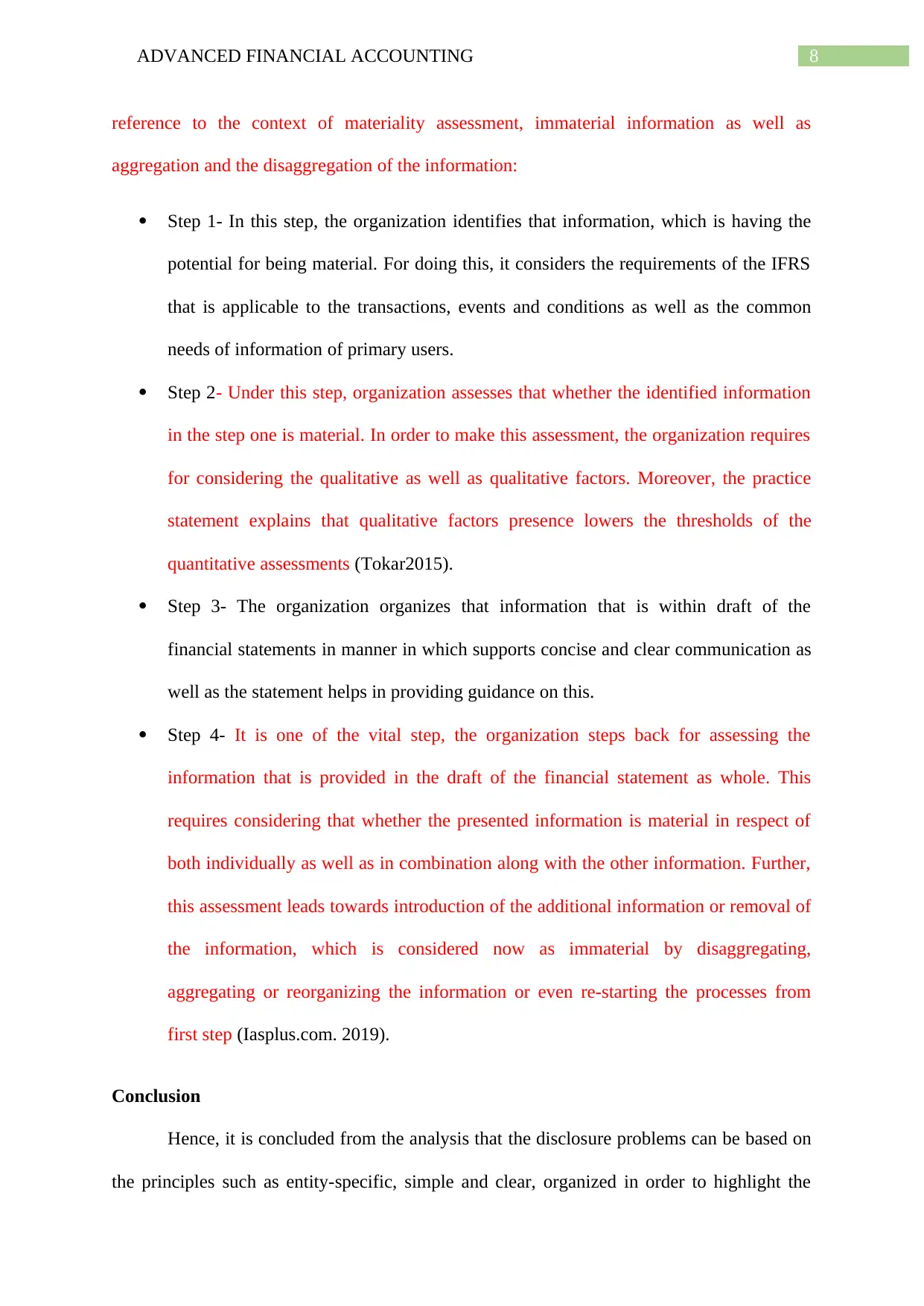
8ADVANCED FINANCIAL ACCOUNTING
reference to the context of materiality assessment, immaterial information as well as
aggregation and the disaggregation of the information:
Step 1- In this step, the organization identifies that information, which is having the
potential for being material. For doing this, it considers the requirements of the IFRS
that is applicable to the transactions, events and conditions as well as the common
needs of information of primary users.
Step 2- Under this step, organization assesses that whether the identified information
in the step one is material. In order to make this assessment, the organization requires
for considering the qualitative as well as qualitative factors. Moreover, the practice
statement explains that qualitative factors presence lowers the thresholds of the
quantitative assessments (Tokar2015).
Step 3- The organization organizes that information that is within draft of the
financial statements in manner in which supports concise and clear communication as
well as the statement helps in providing guidance on this.
Step 4- It is one of the vital step, the organization steps back for assessing the
information that is provided in the draft of the financial statement as whole. This
requires considering that whether the presented information is material in respect of
both individually as well as in combination along with the other information. Further,
this assessment leads towards introduction of the additional information or removal of
the information, which is considered now as immaterial by disaggregating,
aggregating or reorganizing the information or even re-starting the processes from
first step (Iasplus.com. 2019).
Conclusion
Hence, it is concluded from the analysis that the disclosure problems can be based on
the principles such as entity-specific, simple and clear, organized in order to highlight the
reference to the context of materiality assessment, immaterial information as well as
aggregation and the disaggregation of the information:
Step 1- In this step, the organization identifies that information, which is having the
potential for being material. For doing this, it considers the requirements of the IFRS
that is applicable to the transactions, events and conditions as well as the common
needs of information of primary users.
Step 2- Under this step, organization assesses that whether the identified information
in the step one is material. In order to make this assessment, the organization requires
for considering the qualitative as well as qualitative factors. Moreover, the practice
statement explains that qualitative factors presence lowers the thresholds of the
quantitative assessments (Tokar2015).
Step 3- The organization organizes that information that is within draft of the
financial statements in manner in which supports concise and clear communication as
well as the statement helps in providing guidance on this.
Step 4- It is one of the vital step, the organization steps back for assessing the
information that is provided in the draft of the financial statement as whole. This
requires considering that whether the presented information is material in respect of
both individually as well as in combination along with the other information. Further,
this assessment leads towards introduction of the additional information or removal of
the information, which is considered now as immaterial by disaggregating,
aggregating or reorganizing the information or even re-starting the processes from
first step (Iasplus.com. 2019).
Conclusion
Hence, it is concluded from the analysis that the disclosure problems can be based on
the principles such as entity-specific, simple and clear, organized in order to highlight the
⊘ This is a preview!⊘
Do you want full access?
Subscribe today to unlock all pages.

Trusted by 1+ million students worldwide
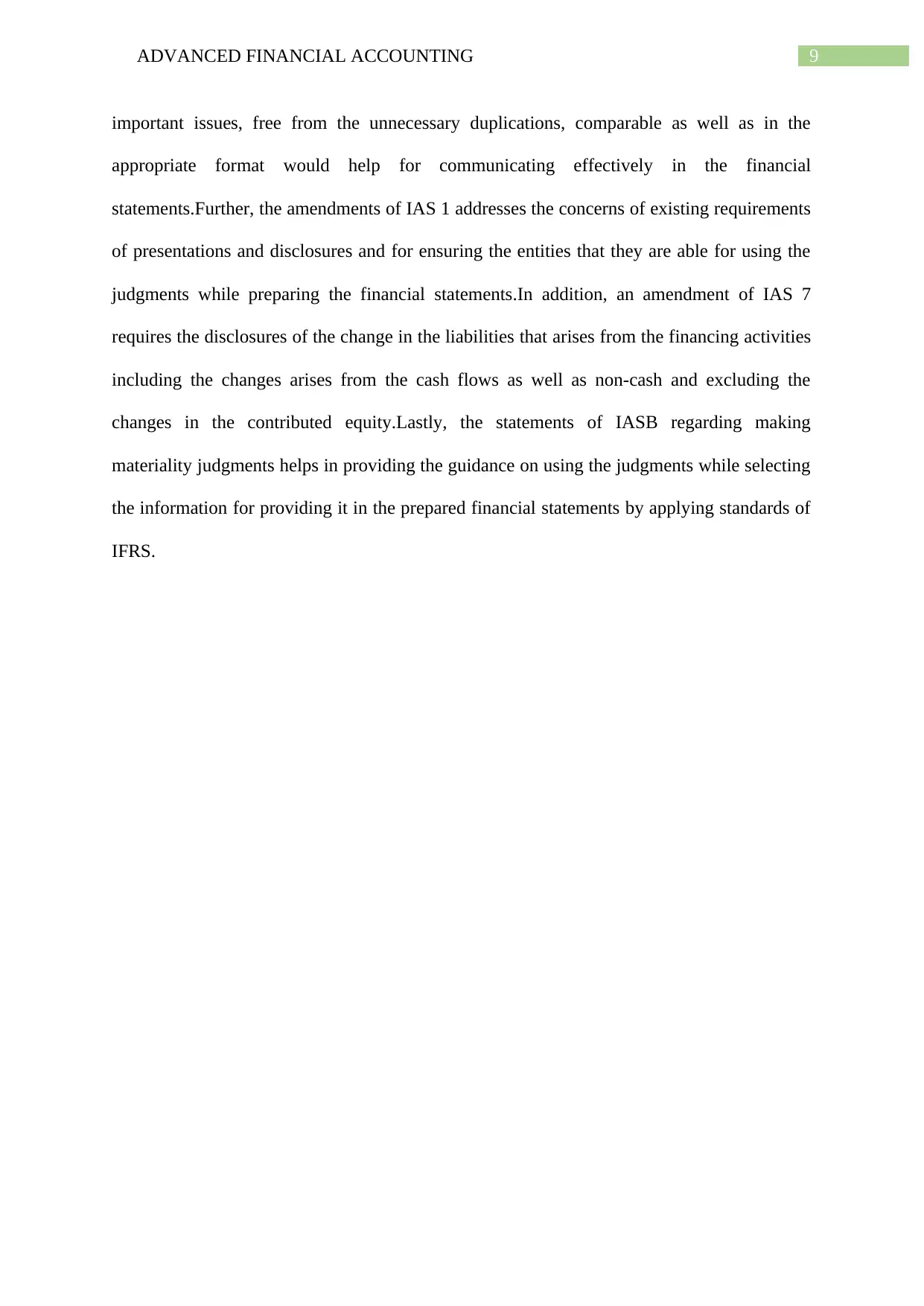
9ADVANCED FINANCIAL ACCOUNTING
important issues, free from the unnecessary duplications, comparable as well as in the
appropriate format would help for communicating effectively in the financial
statements.Further, the amendments of IAS 1 addresses the concerns of existing requirements
of presentations and disclosures and for ensuring the entities that they are able for using the
judgments while preparing the financial statements.In addition, an amendment of IAS 7
requires the disclosures of the change in the liabilities that arises from the financing activities
including the changes arises from the cash flows as well as non-cash and excluding the
changes in the contributed equity.Lastly, the statements of IASB regarding making
materiality judgments helps in providing the guidance on using the judgments while selecting
the information for providing it in the prepared financial statements by applying standards of
IFRS.
important issues, free from the unnecessary duplications, comparable as well as in the
appropriate format would help for communicating effectively in the financial
statements.Further, the amendments of IAS 1 addresses the concerns of existing requirements
of presentations and disclosures and for ensuring the entities that they are able for using the
judgments while preparing the financial statements.In addition, an amendment of IAS 7
requires the disclosures of the change in the liabilities that arises from the financing activities
including the changes arises from the cash flows as well as non-cash and excluding the
changes in the contributed equity.Lastly, the statements of IASB regarding making
materiality judgments helps in providing the guidance on using the judgments while selecting
the information for providing it in the prepared financial statements by applying standards of
IFRS.
Paraphrase This Document
Need a fresh take? Get an instant paraphrase of this document with our AI Paraphraser
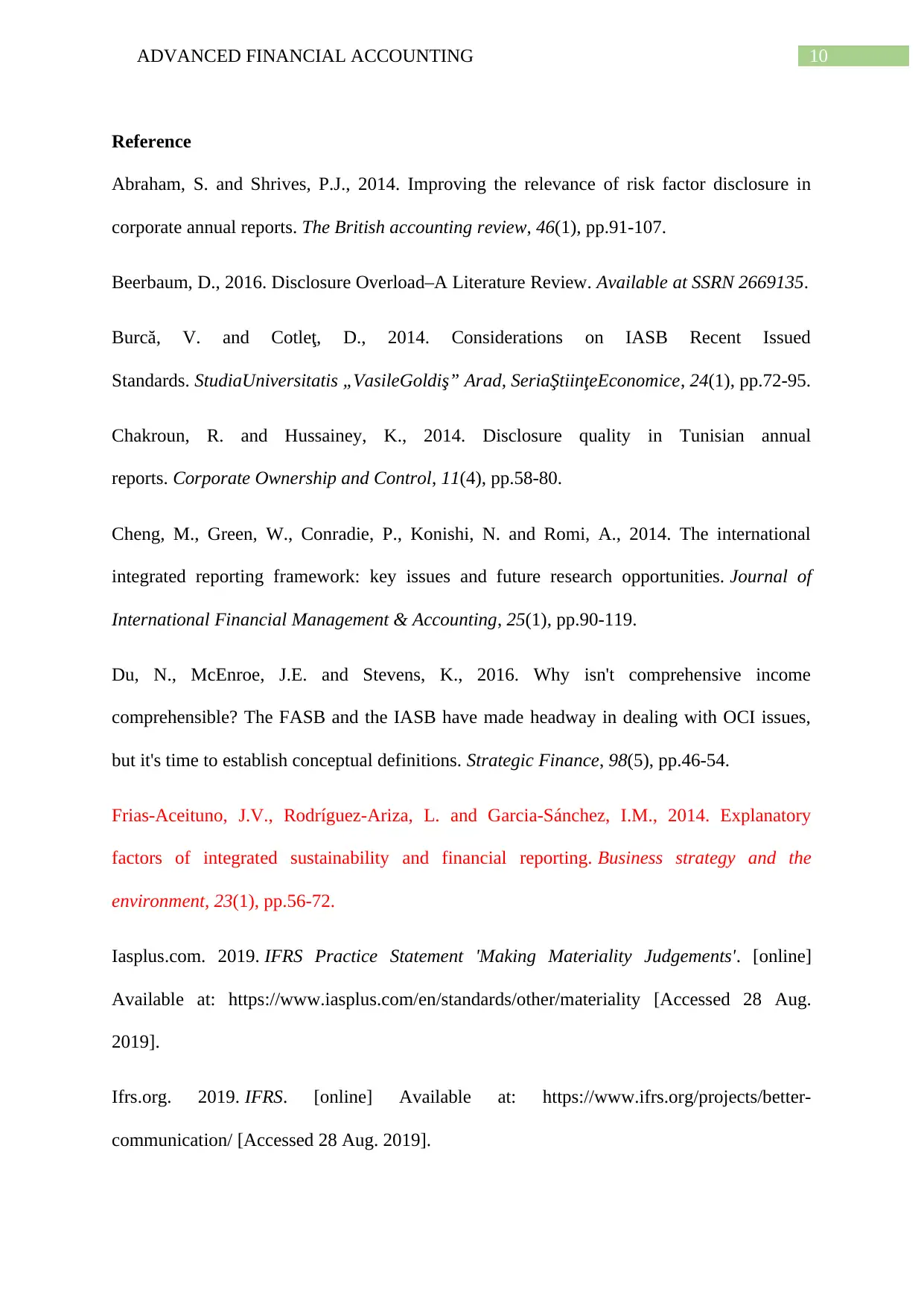
10ADVANCED FINANCIAL ACCOUNTING
Reference
Abraham, S. and Shrives, P.J., 2014. Improving the relevance of risk factor disclosure in
corporate annual reports. The British accounting review, 46(1), pp.91-107.
Beerbaum, D., 2016. Disclosure Overload–A Literature Review. Available at SSRN 2669135.
Burcă, V. and Cotleţ, D., 2014. Considerations on IASB Recent Issued
Standards. StudiaUniversitatis „VasileGoldiş” Arad, SeriaŞtiinţeEconomice, 24(1), pp.72-95.
Chakroun, R. and Hussainey, K., 2014. Disclosure quality in Tunisian annual
reports. Corporate Ownership and Control, 11(4), pp.58-80.
Cheng, M., Green, W., Conradie, P., Konishi, N. and Romi, A., 2014. The international
integrated reporting framework: key issues and future research opportunities. Journal of
International Financial Management & Accounting, 25(1), pp.90-119.
Du, N., McEnroe, J.E. and Stevens, K., 2016. Why isn't comprehensive income
comprehensible? The FASB and the IASB have made headway in dealing with OCI issues,
but it's time to establish conceptual definitions. Strategic Finance, 98(5), pp.46-54.
Frias‐Aceituno, J.V., Rodríguez‐Ariza, L. and Garcia‐Sánchez, I.M., 2014. Explanatory
factors of integrated sustainability and financial reporting. Business strategy and the
environment, 23(1), pp.56-72.
Iasplus.com. 2019. IFRS Practice Statement 'Making Materiality Judgements'. [online]
Available at: https://www.iasplus.com/en/standards/other/materiality [Accessed 28 Aug.
2019].
Ifrs.org. 2019. IFRS. [online] Available at: https://www.ifrs.org/projects/better-
communication/ [Accessed 28 Aug. 2019].
Reference
Abraham, S. and Shrives, P.J., 2014. Improving the relevance of risk factor disclosure in
corporate annual reports. The British accounting review, 46(1), pp.91-107.
Beerbaum, D., 2016. Disclosure Overload–A Literature Review. Available at SSRN 2669135.
Burcă, V. and Cotleţ, D., 2014. Considerations on IASB Recent Issued
Standards. StudiaUniversitatis „VasileGoldiş” Arad, SeriaŞtiinţeEconomice, 24(1), pp.72-95.
Chakroun, R. and Hussainey, K., 2014. Disclosure quality in Tunisian annual
reports. Corporate Ownership and Control, 11(4), pp.58-80.
Cheng, M., Green, W., Conradie, P., Konishi, N. and Romi, A., 2014. The international
integrated reporting framework: key issues and future research opportunities. Journal of
International Financial Management & Accounting, 25(1), pp.90-119.
Du, N., McEnroe, J.E. and Stevens, K., 2016. Why isn't comprehensive income
comprehensible? The FASB and the IASB have made headway in dealing with OCI issues,
but it's time to establish conceptual definitions. Strategic Finance, 98(5), pp.46-54.
Frias‐Aceituno, J.V., Rodríguez‐Ariza, L. and Garcia‐Sánchez, I.M., 2014. Explanatory
factors of integrated sustainability and financial reporting. Business strategy and the
environment, 23(1), pp.56-72.
Iasplus.com. 2019. IFRS Practice Statement 'Making Materiality Judgements'. [online]
Available at: https://www.iasplus.com/en/standards/other/materiality [Accessed 28 Aug.
2019].
Ifrs.org. 2019. IFRS. [online] Available at: https://www.ifrs.org/projects/better-
communication/ [Accessed 28 Aug. 2019].
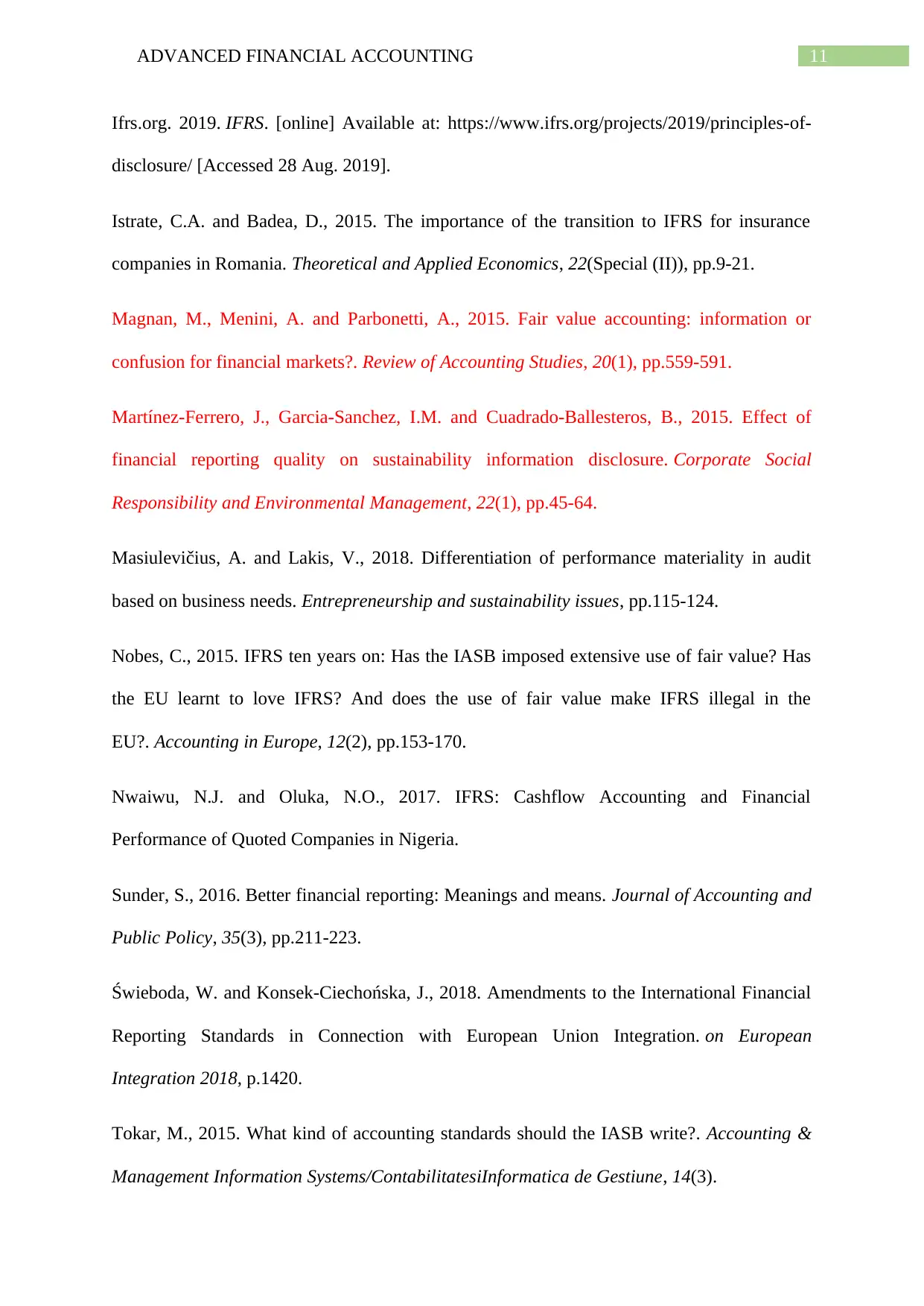
11ADVANCED FINANCIAL ACCOUNTING
Ifrs.org. 2019. IFRS. [online] Available at: https://www.ifrs.org/projects/2019/principles-of-
disclosure/ [Accessed 28 Aug. 2019].
Istrate, C.A. and Badea, D., 2015. The importance of the transition to IFRS for insurance
companies in Romania. Theoretical and Applied Economics, 22(Special (II)), pp.9-21.
Magnan, M., Menini, A. and Parbonetti, A., 2015. Fair value accounting: information or
confusion for financial markets?. Review of Accounting Studies, 20(1), pp.559-591.
Martínez‐Ferrero, J., Garcia‐Sanchez, I.M. and Cuadrado‐Ballesteros, B., 2015. Effect of
financial reporting quality on sustainability information disclosure. Corporate Social
Responsibility and Environmental Management, 22(1), pp.45-64.
Masiulevičius, A. and Lakis, V., 2018. Differentiation of performance materiality in audit
based on business needs. Entrepreneurship and sustainability issues, pp.115-124.
Nobes, C., 2015. IFRS ten years on: Has the IASB imposed extensive use of fair value? Has
the EU learnt to love IFRS? And does the use of fair value make IFRS illegal in the
EU?. Accounting in Europe, 12(2), pp.153-170.
Nwaiwu, N.J. and Oluka, N.O., 2017. IFRS: Cashflow Accounting and Financial
Performance of Quoted Companies in Nigeria.
Sunder, S., 2016. Better financial reporting: Meanings and means. Journal of Accounting and
Public Policy, 35(3), pp.211-223.
Świeboda, W. and Konsek-Ciechońska, J., 2018. Amendments to the International Financial
Reporting Standards in Connection with European Union Integration. on European
Integration 2018, p.1420.
Tokar, M., 2015. What kind of accounting standards should the IASB write?. Accounting &
Management Information Systems/ContabilitatesiInformatica de Gestiune, 14(3).
Ifrs.org. 2019. IFRS. [online] Available at: https://www.ifrs.org/projects/2019/principles-of-
disclosure/ [Accessed 28 Aug. 2019].
Istrate, C.A. and Badea, D., 2015. The importance of the transition to IFRS for insurance
companies in Romania. Theoretical and Applied Economics, 22(Special (II)), pp.9-21.
Magnan, M., Menini, A. and Parbonetti, A., 2015. Fair value accounting: information or
confusion for financial markets?. Review of Accounting Studies, 20(1), pp.559-591.
Martínez‐Ferrero, J., Garcia‐Sanchez, I.M. and Cuadrado‐Ballesteros, B., 2015. Effect of
financial reporting quality on sustainability information disclosure. Corporate Social
Responsibility and Environmental Management, 22(1), pp.45-64.
Masiulevičius, A. and Lakis, V., 2018. Differentiation of performance materiality in audit
based on business needs. Entrepreneurship and sustainability issues, pp.115-124.
Nobes, C., 2015. IFRS ten years on: Has the IASB imposed extensive use of fair value? Has
the EU learnt to love IFRS? And does the use of fair value make IFRS illegal in the
EU?. Accounting in Europe, 12(2), pp.153-170.
Nwaiwu, N.J. and Oluka, N.O., 2017. IFRS: Cashflow Accounting and Financial
Performance of Quoted Companies in Nigeria.
Sunder, S., 2016. Better financial reporting: Meanings and means. Journal of Accounting and
Public Policy, 35(3), pp.211-223.
Świeboda, W. and Konsek-Ciechońska, J., 2018. Amendments to the International Financial
Reporting Standards in Connection with European Union Integration. on European
Integration 2018, p.1420.
Tokar, M., 2015. What kind of accounting standards should the IASB write?. Accounting &
Management Information Systems/ContabilitatesiInformatica de Gestiune, 14(3).
⊘ This is a preview!⊘
Do you want full access?
Subscribe today to unlock all pages.

Trusted by 1+ million students worldwide
1 out of 12
Related Documents
Your All-in-One AI-Powered Toolkit for Academic Success.
+13062052269
info@desklib.com
Available 24*7 on WhatsApp / Email
![[object Object]](/_next/static/media/star-bottom.7253800d.svg)
Unlock your academic potential
Copyright © 2020–2025 A2Z Services. All Rights Reserved. Developed and managed by ZUCOL.




